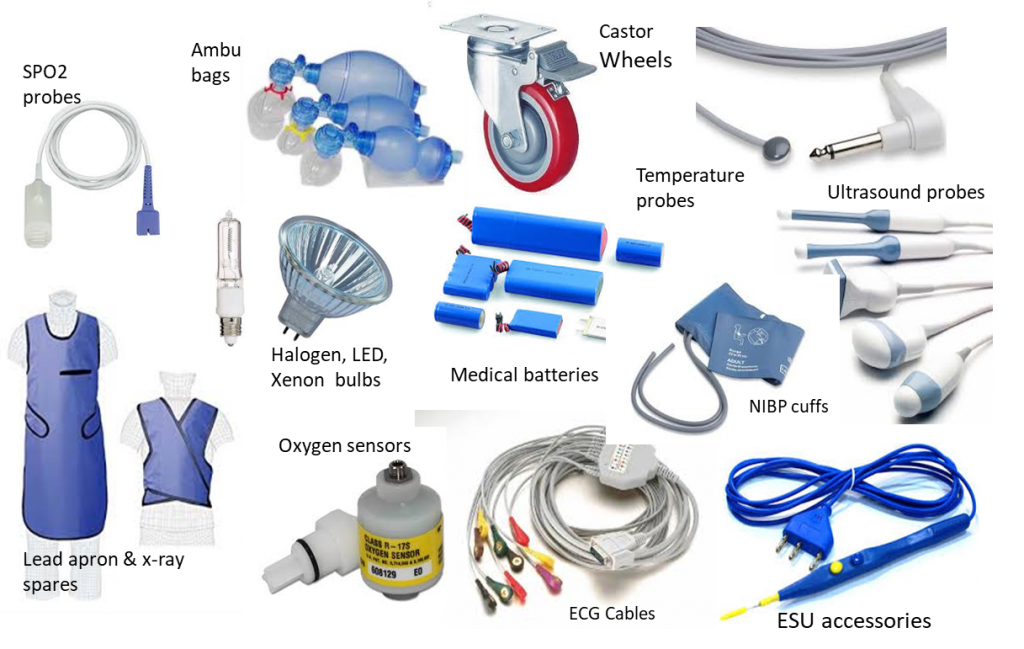
PrimedeQ can supply all types of used and new spare parts & accessories for medical equipment . Contact us on +917019759765 or +918971223957 or write to us at [email protected] for any assistance in this area.
—————————————————————————————————————–
Medical equipment are an expensive affair. Medical equipment cost can be anywhere between 10-30% of the capital investment required to start a hospital. Thereafter they have to be maintained properly for optimal results, longer-life and patient and user safety. All bio-medical departments must constantly manage the operating and maintenance cost of medical equipment judiciously.
Operating costs of medical equipment can be classified as follows:
1. Consumables costs (related to spares parts, consumables such as ECG paper and Gel),
a. biomedical spare parts and accessories, which includes main board, chassis parts, monitor parts,
b. biomedical consumables, which include gels, solutions, printer rolls etc.
2. Service and maintenance costs (such as AMC, calibration etc.) and
3. Other costs like condemnation/ disposal costs.
Additional parts, such as probes/ transducers are often considered part of the equipment itself.
When hospitals consider medical device operating & maintenance costs, equipment are typically classified as high, medium, low and simple technology, based on technological complexity/ development level, availability of maintenance skills & spare parts as well as price values. There is normally a strong correlation between the purchase cost and the maintenance costs of medical equipment.
As per an article published on ‘Cost of medical device spare parts’ in upon examination of the cost expenses of previous years, in affiliated hospitals of Istanbul Public Hospital Unions; the ratio of the annual cost of spare parts to the total cost of acquisition was calculated approximately as 10% for high technology devices, 5% for medium technology, 1.25% for low technology and 0.25% for simple technology. Similar costs can be assumed in general for budgetary planning purposes, while for actual inventory of spares and accessories one needs to study their own usage patterns in the past.
On the basis of technology complexity, purchase cost and service-maintenance requirements of medical equipment, we can divide all equipment / devices in four groups/ levels as follows:
1. High technology – Radiotherapy, Diagnostic Radiology Devices etc.,
2. Medium technology – Anesthesia, Ventilator, Dialysis Systems, etc. This group needs continuous maintenance and certain parts replacement by only specialized technical staff.
3. Low-technology – Vitals monitoring and measurement equipment such as ECG, Patient monitors, etc.,
4. Simple technology – nebulizers, aspirators, oxygen therapy devices, etc. that can be even used at home by non-medical people.

Maintenance frequency
For most of the equipment preventive maintenance needs to be done twice-a-year. In case of critical care equipment like ventilators and anesthesia machine thrice-a-year is recommended. Yearly calibration or quality assurance checks must be done for most of the low/medium/high technology level items. Hence the cost of AMC/CMC and calibration services must be accordingly assumed for each of the equipment.
Most commonly required spares & accessories
Maximum consumables and accessories requirements come from the Critical Care equipment falling in the medium/low technology categories. What are the frequently required spares & accessories? The following section gives equipment wise details:
• X-Ray: Collimator bulb, lead apron
• C-arm: hose pipes, castor wheels, control switch
• Ultrasound machine: Gel, thermal printer paper, Probes
• Ventilators: flow sensors, Patient circuit, O2 sensor, test lung, bacteria filter
• Anesthesia machine: Drugs (isoflurane, sevoflurane etc.), Patient circuit, Bain circuit, etco2 sensor, O2 sensor, flow sensor, soda lime, test lung
• Defibrillator: Gel, ECG electrodes, ECG cables, printer roll, batteries
• ECG: ECG gel, ECG electrodes, ECG cable, clamps, ECG printer paper
• Patient monitors – saturation probe, NIBP cuff, ECG cable, SPO2 probe, ECG lead-sets, ECG Extensions, NIBP cuff connectors, NIBP hose, Temperature sensor, IBP Cable, Batteries, Rubber bulb, control valve, rubber bag, cloth bag for BP apparatus
• Fumigator: Carbon brush, fumigation liquid
• Autoclaves: Heater coil, silicon gasket
• Infant Warmer: Skin temperature probe, air temperature probe, heater coil
• Phototherapy: LED/ CFL Bulbs
• Diathermy: Grounding pad, palm heating pad, cable, gel, foot-switch, unipolar & bipolar electrode
By Type – commonly required spare parts and accessories across different equipment can be classified as follows:
1. Displays & Touch Screens
2. Foot Switches & Hand Controls
3. Printer Papers
4. Rollers & Belts
5. ECG Cables & Leads
6. Consumables & Disposables
7. Mounts, Brackets & Stands
8. NIBP Cuffs & Hoses
9. Spo2 Cables & Sensors
10. Temperature Probes & Cables
11. Co2 Sensors & Cables
12. Keypads & Overlay
13. IBP Cables
14. Fiber-Optic Cables & Headbands
15. Mattress & Pads
16. Probes & Transducers
17. Castor wheels
18. Batteries
19. Halogen or LED Xenon lamps – For OT Lights, Light sources or microscopes
Spares inventory
If it is a large hospital with hundreds of patient monitors, ECG machines etc. ,they may decide to stock some frequently used spares and accessories – items like SPO2 probes, NIBP cuffs, lamps etc. The inventory level depends on the number of equipment, patient volumes/ usage biomedical engineer etc. For smaller hospitals it makes sense to order when required.
